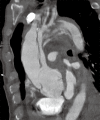Cerebral perfusion issues in type A aortic dissection
- PMID: 29780723
- PMCID: PMC5945856
- DOI: 10.21037/jovs.2018.03.20
Cerebral perfusion issues in type A aortic dissection
Abstract
Stroke events are very common in acute type A aortic dissection. Cerebral malperfusion could manifest at presentation due to prolonged arch vessels hypoperfusion or develop after surgery for inadequate cerebral protection during arch repair. To reduce this detrimental complication there are several adjuncts that can be adopted for cerebral protection such as direct antegrade or retrograde cerebral perfusion (RCP) and use period of deep to moderate hypothermic circulatory arrest time; however, they are often insufficient as preoperative malperfusion already caused irreversible ischemic damages. The aim of the current review article is to analyze the principal series reporting on neurological injuries during type A aortic dissection to focus on the outcomes according to the type of surgical management and identify possible predictors to better manage this complication.
Keywords: Type A aortic dissection; antegrade selective cerebral perfusion (ASCP); brain protection; cerebral perfusion; hypothermic circulatory arrest.
Conflict of interest statement
Conflicts of Interest: The authors have no conflicts of interest to declare.
Figures


Similar articles
-
Simple retrograde cerebral perfusion is as good as complex antegrade cerebral perfusion for hemiarch replacement.J Vis Surg. 2018 Mar 13;4:50. doi: 10.21037/jovs.2018.02.10. eCollection 2018. J Vis Surg. 2018. PMID: 29682460 Free PMC article.
-
Antegrade selective cerebral perfusion with mild hypothermic systemic circulatory arrest during thoracic aortic surgery.Scand Cardiovasc J. 2005 Apr;39(1-2):87-90. doi: 10.1080/14017430410004614. Scand Cardiovasc J. 2005. PMID: 16097420
-
Cerebral Protection Strategies and Stroke in Surgery for Acute Type A Aortic Dissection.J Clin Med. 2023 Mar 15;12(6):2271. doi: 10.3390/jcm12062271. J Clin Med. 2023. PMID: 36983272 Free PMC article. Review.
-
Intermittent antegrade/selective cerebral perfusion during circulatory arrest for repair of the aortic arch.Perfusion. 1997 Mar;12(2):127-32. doi: 10.1177/026765919701200207. Perfusion. 1997. PMID: 9160364 Review.
-
Integrated cerebral protection: combined antegrade and retrograde cerebral perfusion during deep hypothermic circulatory arrest.Innovations (Phila). 2010 Sep;5(5):355-8. doi: 10.1097/IMI.0b013e3181f88dc5. Innovations (Phila). 2010. PMID: 22437521
Cited by
-
Risk prediction of postoperative permanent stroke in acute type A aortic dissection patients with severe common carotid artery stenosis using brain CT perfusion.Heliyon. 2024 Aug 22;10(17):e36740. doi: 10.1016/j.heliyon.2024.e36740. eCollection 2024 Sep 15. Heliyon. 2024. PMID: 39263105 Free PMC article.
-
Commentary: Preoperative cerebral malperfusion in aortic dissection: Symptoms may be deceivers.JTCVS Tech. 2021 Oct 19;10:196-197. doi: 10.1016/j.xjtc.2021.10.024. eCollection 2021 Dec. JTCVS Tech. 2021. PMID: 34984379 Free PMC article. No abstract available.
-
Preoperative Imaging Risk Findings for Postoperative New Stroke in Patients With Acute Type A Aortic Dissection.Front Cardiovasc Med. 2020 Nov 30;7:602610. doi: 10.3389/fcvm.2020.602610. eCollection 2020. Front Cardiovasc Med. 2020. PMID: 33330666 Free PMC article.
-
The strategy of cardiopulmonary bypass for total aortic arch replacement and the frozen elephant trunk technique with aortic balloon occlusion.J Int Med Res. 2020 May;48(5):300060520905410. doi: 10.1177/0300060520905410. J Int Med Res. 2020. PMID: 32357091 Free PMC article.
-
Outcomes of surgery for acute type A dissection in octogenarians versus non-octogenarians: a systematic review and meta analysis.J Cardiothorac Surg. 2022 Sep 1;17(1):222. doi: 10.1186/s13019-022-01980-x. J Cardiothorac Surg. 2022. PMID: 36050776 Free PMC article.
References
Publication types
LinkOut - more resources
Full Text Sources
Other Literature Sources
